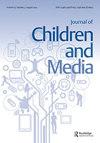U.S. co-viewing during COVID
IF 2.1
3区 心理学
Q2 COMMUNICATION
引用次数: 0
Abstract
My family of five has a lot of moving parts, and on 12 March 2020 those parts were running like clockwork. Then COVID-19 happened. 13 March 2020 brought lockdown. Quarantine. Isolation. The cog of COVID-19 screeched our well-oiled machine to a halt. In retrospect, that forced stoppage of our everyday “normal” brought clarity to both my personal life and professional life. As a researcher of “teachable moments” in children’s media (movies, shows, episodes, storylines and characters that can be employed as discussion starters between parents and children) I was provided a unique opportunity to interweave my personal and professional life. A fundamental ingredient of teachable moments is parental co-viewing and inherent in this research agenda is the assumption that co-viewing can be a valuable family practice. What happens to co-viewing during a pandemic? The COVID-19 pandemic created opportunities that were previously unavailable, if not unheard of, in my household and provided insight for my research as well as a unique perspective of my family dynamics. From the academic viewpoint, I found that co-viewing – in my own anecdotal experience – could be used valuably in multiple ways. Besides my aforementioned “teachable moments” and conversation starters of larger life lessons, parents and children can actual learn new things together. Co-viewing can serve as a springboard to explore new phenomena. For example, my daughter and I watched the entire first season of Crikey: It’s the Irwins (airing on Animal Planet) together during lockdown. This program follows the family of (the deceased) Crocodile Hunter, Steve Irwin, at Australia Zoo. Each episode features different species of wildlife, many native to Australia. There are animal births, animal deaths, and a plethora of animal experiences in between. Through watching this program my daughter was introduced to Australia and to many new animals she had not been exposed to in the past. In addition to viewing the program, we then explored where Australia was on the map, which led to discussions on geography and culture. We pulled out her animal books and flipped through the pages together pointing out animals that were similar to what we saw on television. In another case, my daughter, my husband and I all watched the most current season of Top Chef (airing on Bravo). This was different than the previous example in that this program aired weekly new episodes, so we were scheduling our time to watch this together every week up until the finale. This was much more “appointment television” rather than “binge-COVID期间美国共同观察
我一家五口有很多活动部件,2020年3月12日,这些部件运行得像钟表一样。然后新冠肺炎发生了。2020年3月13日实行封锁。隔离期隔离新冠肺炎的齿轮使我们运转良好的机器急刹车。回想起来,我们日常“正常”的被迫停止让我的个人生活和职业生活都变得清晰起来。作为儿童媒体中“可教时刻”(电影、节目、剧集、故事情节和角色,可以作为父母和孩子之间的讨论起点)的研究者,我获得了一个独特的机会,可以将我的个人生活和职业生活交织在一起。可教时刻的一个基本组成部分是父母共同观看,而这项研究议程中固有的假设是,共同观看可能是一种有价值的家庭实践。在疫情期间,共同观看会发生什么?新冠肺炎大流行在我的家庭中创造了以前无法获得的机会,即使不是闻所未闻的,也为我的研究提供了见解,并为我的家庭动态提供了独特的视角。从学术角度来看,我发现共同观看——根据我自己的轶事经验——可以以多种方式进行有价值的使用。除了我前面提到的“可教时刻”和大型生活课程的开场白之外,父母和孩子实际上可以一起学习新东西。共同观看可以作为探索新现象的跳板。例如,我和女儿在封锁期间一起观看了《Crikey:It’s Irwins》(在《动物星球》上播出)的整个第一季。本节目讲述了澳大利亚动物园鳄鱼猎人史蒂夫·欧文的家人。每一集都有不同种类的野生动物,其中许多原产于澳大利亚。其间有动物出生,动物死亡,以及大量的动物经历。通过观看这个节目,我的女儿被介绍到了澳大利亚,以及许多她过去没有接触过的新动物。除了观看节目外,我们还探索了澳大利亚在地图上的位置,这引发了关于地理和文化的讨论。我们拿出她的动物书籍,一起翻页,指出与我们在电视上看到的动物相似的动物。在另一个案例中,我的女儿、丈夫和我都观看了最新一季的《顶级厨师》(在Bravo上播出)。这与之前的例子不同,因为这个节目每周都会播出新的剧集,所以我们每周都会安排时间一起看,直到最后一集。这更像是“预约电视”,而不是“狂欢”-
本文章由计算机程序翻译,如有差异,请以英文原文为准。
求助全文
约1分钟内获得全文
求助全文

 求助内容:
求助内容: 应助结果提醒方式:
应助结果提醒方式:


